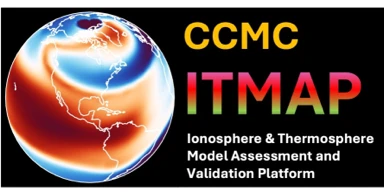CCMC ITMAP
About
The CCMC Ionosphere-Thermosphere Model Assessment and validation Platform (ITMAP) is an interactive web-based application that supports comprehensive evaluation of ionosphere and thermosphere (IT) models. ITMAP integrates a wide range of observational datasets, including those from ground-based GNSS networks, FORMOSAT-7/COSMIC2, CHAMP, GOCE, GRACE-A, SWARM-A, and GRACE-FO, with state-of-the-art IT models hosted by CCMC and partner institutes.
By combining advanced visualization tools, statistical analyses, data processing pipelines, and community-developed software, ITMAP enables comprehensive model-data comparisons. These intercomparisons help identify model strengths and limitations, ultimately improving model performance and our understanding of near-Earth space environments. ITMAP promotes transparency and reproducibility in model validation.
CCMC has initiated a long-term model validation campaign to assess IT model performance during geomagnetic storms spanning solar cycles 23 to 25. Approximately 200 storm events from 2000 to 2024 have been selected for validation. ITMAP currently hosts model validation results from historic storm events, focusing on four key parameters:
- Total Electron Content (TEC): TEC represents the total number of electrons along a vertical column of the ionosphere and is a crucial parameter for space weather monitoring and GNSS application. In ITMAP, the TEC validation is based on the methodology described in Chou et al. (2023). The corresponding executable paper is also available here. Currently, validation results are presented for two geomagnetic storm events, with additional cases to be added at the project progress.
- foF2 and hmF2: The critical frequency (foF2) and peak height (hmF2) of the ionospheric F2 layer are essential for high-frequency radio communication and ionospheric modeling. In this project, modeled foF2 and hmF2 values are validated against observations from the FORMOSAT-7/COSMIC-2 (F7/C2) radio occultation (RO) dataset. Model-derived foF2 and hmF2 are obtained through Observing System Simulation Experiments (OSSEs)(Chou et al., 2017). This process uses the F7/C2 and GNSS orbit geometries to derive synthetic line-of-sight RO TEC within the ionosphere model. The synthetic TEC data is then inverted to RO electron profile using the Abel inversion, from which modeled foF2 and hmF2 are extracted. These values are directly compared with real F7/C2 observations to assess model accuracy.
- Note: Validation against ground-based ionosonde foF2 and hmF2 data is available through the Comprehensive Assessment of Models and Events using Library Tools (CAMEL) framework.
- Thermospheric Neutral Density: Thermospheric density is the primary source of uncertainty in the atmospheric drag, which directly impacts satellite orbit prediction and reentry calculations. Thermosphere models estimate neutral density, composition, and temperature based on the solar and geomagnetic drivers. Physics-based models with the lower boundary located around the mesopause also require specification of lower atmosphere variability. Biases from thermospheric models are amplified due to the satellite shape and aerodynamic model when calculating the drag force. This, in turn, introduces several error sources originating from the modeled thermospheric states in orbit computation. To make advances in orbit computation and determination, accurate specification and forecasting of thermosphere are required. Modelled neutral density must be validated against high-quality and high-spatial resolution neutral density datasets to identify strengths and weaknesses, establish error budgets, and improve the models after ingestion. An updated metrics for thermospheric model assessment under historic geomagnetic storms were proposed and implemented in the ITMAP validation project (Sutton, 2018; Bruinsma et al., 2021). The metrics for comprehensive thermospheric model-data comparison are applied to establish the thermospheric model scorecard.
Latest News
- May 2025: The ITMAP web app is now available to the community in its beta release (see announcement [PPTX]).
Future Work
Future development of ITMAP will focus on optimizing the web application and expanding the model validation projects to include additional geomagnetic storm events and observational datasets. Planned datasets include measurements from incoherent scatter radars, NASA's ICON and GOLD missions, and other relevant satellite missions. Furthermore, ray tracing and GNSS positioning tools will be integrated to assess model performance in support of real-world navigation and communication applications.
Reference
- Bruinsma S, Boniface C, Sutton EK & Fedrizzi M 2021. Thermosphere modeling capabilities assessment: geomagnetic storms. J. Space Weather Space Clim. 11, 12.https://doi.org/10.1051/swsc/2021002.
- Chou, M.-Y., Yue, J., Wang, J., Huba, J. D., El Alaoui, M., Kuznetsova, M. M., et al. (2023). Validation of ionospheric modeled TEC in the equatorial ionosphere during the 2013 March and 2021 November geomagnetic storms. Space Weather, 21, e2023SW003480. https://doi.org/10.1029/2023SW003480
- Chou, M. Y., C. C. H. Lin, H. F. Tsai, and C. Y. Lin (2017), Ionospheric electron density inversion for Global Navigation Satellite Systems radio occultation using aided Abel inversions, J. Geophys. Res. Space Physics, 122, 1386–1399, doi:10.1002/2016JA023027.
- Sutton EK. 2018. A new method of physics-based data assimilation for the quiet and disturbed thermosphere. Space Weather 16: 736–753. https://doi.org/10.1002/2017SW001785
